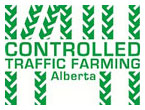Agronomist Notes
Welcome to the 46th and final issue of Beyond Agronomy News for 2008. Looking back on the year, it’s easy to remember the challenges that were thrown at us once again.
We began with a cool wet spring, where soil temperatures hovered below ten degrees for the longest time. Dandelions sprouted up everywhere and the countryside was yellow by mid-May. Many producers seeded into heavy residue and worried about emergence problems, which seemed to be less significant than anticipated. Crops grew slowly and early fall frosts were in the back of our minds. June came around and the weather didn’t improve. Optimum spray timing didn’t exist; you sprayed just to get done. July brought cooler than normal weather with the odd shellacking of hail and crops with shallow roots were given a break from the heat, which I’m sure added 10% to yields. Wheat midge outbreaks were on the radar but thankfully, I didn’t have one field above threshold. Canola insects were kept at bay by the cooler weather and only the usual hot spots warranted lygus bug control. Winter wheat and barley fields took forever to mature, pushing most of harvest into October.
Yield results started pouring in and eye popping yields were achieved in several areas. In the end, average wheat quality was No. 1 or No. 2, with the odd pocket of frost and ergot causing downgrades to feed. Malt barley quality was excellent, however many producers who locked in high priced barley contracts were mysteriously rejected for one reason or another. Finally, canola yields were exceptional in many areas with no mention of downgrades. All in all, a successful year!
This week we’ll take a look back at my notes from the 2008 season to see what stands out. Next, if you remember the JD 1870 and some really heavy residue it seeded into, I’ve got the yield results for a few of those fields. I’ll be travelling once again in 2009 on my Nuffield scholarship and will share what I’m studying and where I’m headed.
We wish you a Merry Christmas and continued success in the New Year. We sincerely thank you for your business and hope you find value in the information we provide each week. Our goal is to become the best agronomic news source in Canada by providing timely, relevant and accurate information. We’ll start back up on January 6th for a new season of Beyond Agronomy News. Have a great holiday!
Agronomy
Steve’s Stocking Stuffers: Cool agronomy tips for 2009
- Wheat on wheat rotations consistently had 10% more seedling mortality than wheat on canola stubble. Keep this in mind when calculating your seeding rates for 2009.
- When scouting for pre-burn applications in canola stubble, be sure to dig below the surface and check for young canola seedlings about to emerge. Switch to a residual product like Pre-Pass if you find more than 2 plants/ft2 or 20 plants/m2 below the surface.
- Do not spray Liberty herbicide when temperatures fall below 12oC. You will have extremely poor weed control. The temperature and sunlight hours received the day after Liberty applications are just as crucial for effective control of broadleaf and grassy weeds.
- Don’t throw money at needless crop protection products just because the price of wheat is $10 and canola is $15 in the spring. Those who used price exclusively as their decision making guide threw profitability out the window.
- We need to reduce the foot print of all our machinery to reduce compaction. I’ve seen compaction from in-crop spraying last spring to heavy harrowing this fall. I’ve seen this for three years now and it has me concerned about future yield loss.
- Infinity herbicide provides the fastest control of volunteer canola of any broadleaf product on the market. You’ll notice white and crispy canola within two days of application.
- In 2008, the highest yielding wheat variety across my territory was CDC Go at 112 bushels per acre.
- In 2008, InVigor 8440 consistently yielded the highest for canola varieties in my territory and travels.
- Wind screens add more work to your spraying operation but offer more flexibility in windy conditions. I watched pull type sprayers with wind screens continue spraying while high clearance sprayers were parked.
- Dandelions will be a problem again next spring. September rains provided another opportunity for fall germination in 2008. Be prepared to increase pre-burn glyphosate rates in 2009.
- A difference of ¾ inches (20 mm) in seeding depth can reduce maturity in barley by 5 days. Barley seeded at a depth of 1 ½ (38 mm) inches this year had one less leaf and tiller compared to barley seeded at ¾ inches deep.
- Winter wheat is an amazing reclamation tool for sandy soil. Winter wheat provides a huge amount of root mass compared to spring cereals. This root mass adds organic matter and improves soil structure by locking soil particles together.
Heavy residue no match for the JD 1870 in 2008
Perhaps you remember an article I wrote about Calvin and Mitch Treacy seeding canola and barley into some gnarly hailed-out stubble that made you shudder just to look at it. The picture to the left was the type of mess they seeded into on many of their acres caused by a major hail storm in July 2007. In spite of turning around many times to dump the residue caught underneath the tool bar, emergence and crop performance didn’t seem to suffer at all. In fact, the malt barley variety Copeland seeded in the picture here went 100 bu/ac (5.4 T/ha). Canola seeded next door in the same kind of mess went 54 bu/ac (3.1 T/ha). I am thoroughly impressed with the JD 1870 after watching what it could do in those extreme conditions. SL
A Nuffield Scholar packs his bags in 2009
I am just beginning to line up my next round of world travels to complete my independent study. I have chosen to interview the world record holders for grain yield. I plan to investigate the philosophies, climate and management techniques of these individuals who produce world record yields. I’ll take the newsletter on the road and show you my discoveries along the way.
My travels will take me to New Zealand where two record holders reside; one owns the record for 150 bu/ac spring wheat and the other, 257 bu/ac winter wheat. I’ll make my way to the US to visit the world record soybean grower (154 bu/ac) and up through to Iowa to visit the producer who owns the record for 442 bu/ac corn. I’ll also take a look at intensive wheat production in the UK to see how they manage 150 bu/ac wheat and 180 bu/ac barley. I plan on stopping throughout Australia to visit friends and learn more about controlled traffic farming, inter-row seeding and how some manage to grow so much grain on such little moisture. SL
Beyond Agronomy client meeting
I hosted the 3rd annual Beyond Agronomy meeting for our clients at the Sheraton this year. Gregg Doud, Chief Economist for the American Cattlemen’s Beef Association, spoke to us about poultry, pork, beef and grain demand in the coming year. Greg mentioned five indicators we should look for that will signal the beginning of an upward trend in the grain market:
- Watch for the price of oil versus the US dollar. When oil begins to climb and the US dollar begins to drop, that will be a signal that investors are getting out of the security of the US dollar and back into commodities.
- Canola tracks closely to the price of soybeans. The price of soybeans is always 2.5 times the price of corn and the price of corn follows the price of oil. Subsequently, you can get a clearer picture of where oilseeds are going by watching the price of oil.
- Watch for increased levels of open interest in grain markets. The open activity (number of open positions, long or short) in grain markets has been very low with the recent pull back from investment funds. If you begin to see increased open interest in commodities, it will be a sign that investors are moving back into commodities. Investment funds flock to commodities as a method of hedging inflation. After the brief period of deflation we are experiencing right now, we should see a rapid shift to higher inflation from the excess supply of US currency.
- The only commodity or equity chart that has pointed upward since last August is the US Treasury Note. Watch for the price of US Treasury Notes to decline as an indicator that investors are finding more comfort in investing outside US Treasuries and back into commodities and equities.
- Watch for Brazil, Russia, India and Chinese investors (the BRIC) to get back into the market once the price of oil climbs back above $60 US a barrel. Russia, for example, needs oil prices above $60 US a barrel to operate their economy.
Upcoming Conferences and Training Schools
Triticale Agronomy Training Session
Lacombe Research Station
December 16, 2008
Phone: 780-674-8268
FarmTech
Edmonton, AB
January 28-30, 2009
http://www.farmtechconference.com/register.html
Agronomy Update
Lethbridge, AB
January 20-21, 2009
http://www1.agric.gov.ab.ca/$department/EFE.nsf/all/efe1807
CCA Applied Agronomy Conference
Olds, AB
February 17, 2009
http://www.oldscollege.ca/programs/ContinuingEducation/ag-land-environment/alberta-cca-conference.htm
Markets
International Crop Weather News
United States: On the Plains, snow is developing across northern portions of the region, providing beneficial moisture and cover for winter grains. Meanwhile, warm, breezy, unfavorably dry conditions persist across winter wheat areas on the southeastern Plains. In the Corn Belt, dry weather prevails, except for a band of rain and freezing rain extending along a warm front from central Illinois into the middle Ohio Valley. Milder air is overspreading the southwestern Corn Belt, including Missouri. In the South, milder air is overspreading areas from the Delta westward. Meanwhile, cold weather lingers across the Southeast, where a series of hard freezes as far south as northern Florida have slowed the growth of pastures and winter grains.
Europe: Sub-freezing temperatures and widespread snow ease winter crops into dormancy over central and eastern Europe. A hard freeze settles over western Europe, slowing winter wheat and barley development. Locally heavy rain in Italy and western portions of the Balkans favors emerging winter grains.
Former Soviet Union: Above-normal temperatures favor winter grains that continue easing into dormancy in Ukraine and the Southern District in Russia. Most winter grain areas lack a protective snow cover, leaving them vulnerable to weather extremes.
Southeast Asia: Flooding persists in minor agricultural areas of the northeastern Philippines. Showers cause few delays in coffee and rice harvesting in Vietnam.
South Asia: Tropical Cyclone Nisha brings heavy rain and gusty winds to Sri Lanka and southern India, halting groundnut harvesting and knocking maturing fruit off coffee trees.
Middle East: Rain in Turkey and Syria provides additional topsoil moisture for vegetative winter wheat and barley.
Northwest Africa: Showers in Morocco and Algeria slow winter grain planting but maintain favorable moisture for crop emergence and establishment. Dry weather in Tunisia allows fieldwork to resume following last week’s rain.
Australia: Widespread, locally heavy rain continues in eastern Australia, improving moisture supplies for summer crops but further delaying winter grain harvesting and increasing concerns about crop quality. In western Victoria and South Australia, mostly dry weather favors rapid winter grain harvesting, while wet weather in southern parts of the Western Australia wheat belt hampers harvesting.
South America: Soaking rain brings needed relief from heat and dryness to most major farming areas of Argentina. Warm, dry weather reduces topsoil moisture for summer crop germination in southern Brazil, although conditions have improved for maturing winter wheat.
South Africa: Warm, showery weather maintains generally favorable summer crop prospects.





